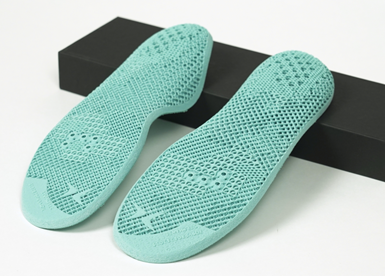The Foot Measurement System That Allows for Mass Customized Insoles
Aetrex’s Albert scanner is an example of how advances in measurement technology aid 3D printing in realizing its promise.

The Albert scanner for customized insoles includes pressure sensors and 18 digital cameras.
Many of the pieces we’ve posted recently explore the connection between additive manufacturing (AM) and measurement. Two articles in particular detail how advanced measurement capability (including capability now in our phones) is used to create 3D printed products tailored to the wearer — dental appliances and eyeglasses. One other example of a customized 3D printed product achieved through measurement are the insoles now available from Aetrex that are finely adapted to both the dimensions and pressure map of each individual wearer’s feet. We devoted an episode of The Cool Parts Show to these insoles, but it is worthwhile to give further attention to the measurement technology that makes theses insoles possible. That measurement technology, the “Albert” scanner, actually came first, before 3D printing entered in.

Senior editor Stephanie Hendrixson having her feet measured by the Albert scanner.
Aetrex introduced the Albert scanner in 2017, and then and now the company believes it to be the most advanced 3D foot scanning system in the world. A combination of 5,000 gold-plated sensors, over 900 infrared LEDs and receptors, and 18 digital cameras all provide rapid measurement of the foot, along with rapid mapping of a detailed pressure profile that reveals how the foot contacts the ground, and how the force of standing is distributed.

Among the results of the scan is a pressure map detailing how the foot contacts the ground. (This is from the scan of the author’s feet.)
Pressure reduction has been a long-standing aim of the company’s footwear orthotics. Initially, Albert scanners were placed in stores to help recommend the best footwear, but it soon became clear that additive manufacturing provided the next step (so to speak). An orthotic customized via 3D printing can precisely match every wearer’s pressure map, essentially bringing the ground up to the foot by tailoring the springiness at every minute area of the insole to the force the foot is experiencing there.

The TPU insoles 3D printed by EOS use digital foam to achieve responsiveness tailored to the wearer’s pressure map.
Aetrex partnered with EOS to develop the system seamlessly translating Albert data into the build file for a thermoplastic polyurethane (TPU) insole tailored to the foot. EOS varies the springiness map throughout the insole using “digital foam” — that is, a foam-like responsiveness created through different 3D printed spring-like geometries delivering different levels of resistance. See more in The Cool Parts Show episode linked above.
Related Content
-
EOS Launches Digital Foam Architects Network
EOS created the collaborative additive manufacturing alliance to accelerate time-to-market for 3D printed foam applications.
-
Lithoz, Himed Partner for Research on 3D-Printable Medical-Grade Bioceramics
This collaboration is designed to help grow the range of biocompatible materials suitable for a future that includes highly customized, patient-specific medical solutions that can be printed on demand.
-
Admatec’s Larger Integrated Binding/Sintering Furnace for Ceramic 3D Printing
Company scales up for more efficient mass customization and serial ceramics 3D printing production lines.












